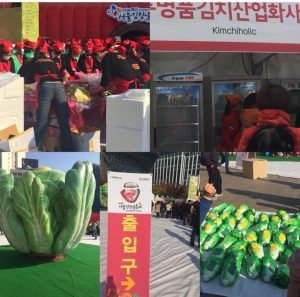Growing up, my dad always had a jar of sour dill pickles in the refrigerator. He enjoyed the crunch, and taste and also put more produce on his plate. The sour, briny flavors of sauerkraut, pickles and olives are great on their own and also paired with other foods and best of all, they add more produce to the plate! Sauerkraut, noodles and yogurt is a delicious and nutritious way to do a perfect produce and dairy pairing. Kalamata olives, and aged cheeses are my go-to appetizer and yogurt is used in every way every day. I had the opportunity to travel to Seoul in 2017 and ever since, have been a kimchi (Korean fermented cabbage) fan. These photos are from a kimchi festival in Seoul.

These foods provide more than great taste. They also have health benefits and are a staple in our house, We are big fans of #fermenttoaugment taste, food safety and health.
So what exactly is fermentation?
This is a process that has been around forever but is now considered to be on trend.
Fermentation occurs when microorganisms such as bacteria, mold, yeast feed on starch, sugar and other food components. The sugar in these foods is converted into acids, alcohol and carbon dioxide. Not only does this enhance flavor and change the texture of foods but also can:
- Enhance the benefits of certain nutrients- increased bioavailability of B vitamins, magnesium and zinc
- Remove/reduce antinutrients in raw foods such as phytic acid
- Improve food safety – fermentation can inhibit the growth of food borne pathogens
- Extend shelf life of foods
- Increase the amount of probiotics (good bacteria) in the gut and
diminish the presence of pathogenic (bad) bacteria
In dairy foods such as yogurt and kefir (a cultured dairy beverage) lactic acid producing bacteria feed on lactose and other sugars in milk to produce compounds that can change the flavor, texture and nutrients. Fermented dairy foods are more digestible than nonfermented milk because the lactose (milk sugar) is broken down, making it easier to tolerate for those with lactose digestion issues. In addition, fermented dairy foods may lower risk of Type II DM, CVD, and overall mortality.
In plant-based fermented foods- fermentation may occur naturally such as in fresh kimchi, sauerkraut, and certain types of dill pickles as well as brine cured olives.
All of these foods contain microbes that are still alive when consumed and therefore confer benefits. You can buy shelf-stable pickles, kimchi, sauerkraut and olives, but the microbes are destroyed during the heating/canning process so you still get the benefits of the vegetables, but not the fermentation.
If your goal is to add more fermented foods to your diet, the label should say naturally fermented. In the refrigerator case, the presence of bubbles in the liquid
(pickles, kimchi, sauerkraut) indicate that those foods are fermented.
Perfect Pairing
- Parmesan with pickles and olives
- Kimchi with yogurt- the heat of the kimchi can be tempered by the creaminess of yogurt
- Kefir- blueberry smoothie
- Sauerkraut with potatoes and yogurt
- Kimchi, broccoli and tofu stirfry
So for improved health on your fridge shelf join the #fermentationnation.
#haveaplant with different types of produce on the plate. Reach across the produce and dairy aisles for the 1-2 punch of nutritious and delicious and get more benefits per bite with taste delights.



